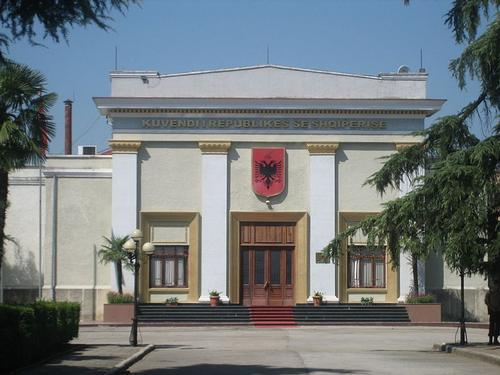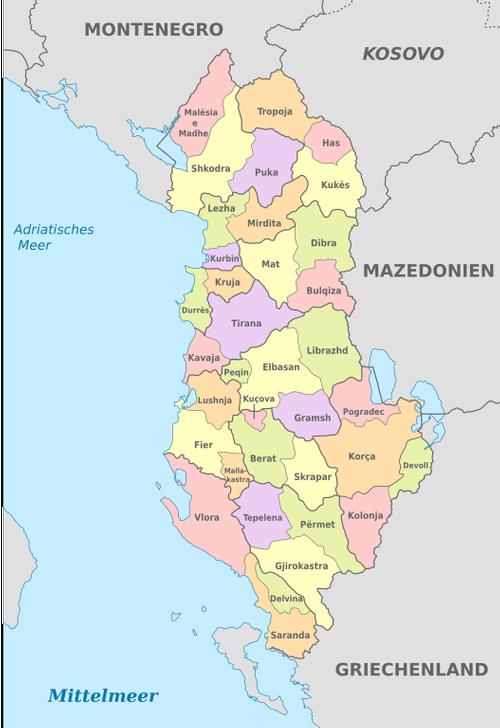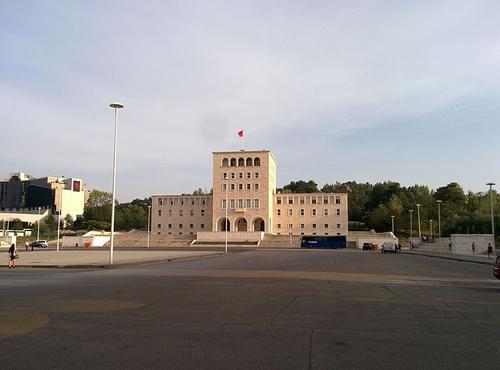ALBANIA
Society

Society
Cities in ALBANIA
| Tirana |
Society
State organization
| advertentie |
|
Car rental in Albania |

Albania Parliament BuildingPhoto: Gertjan R. CC 3.0 Unported no changes made
Between 1948 and 1991, the communist party - officially Albanian Workers' Party (abbreviated: PPSh) - was the only leading political force in state and society. The first free elections took place in 1991 after the fall of the communist regime.
The "one-chamber People's Assembly" or "Kuvendi Popullor" has 140 delegates, who are elected every four years;the People's Assembly elects the head of state. One hundred members of the People's Assembly are elected directly from single constituencies and forty by proportional representation. There is a general obligation to vote from 18 years. The president is the head of state of Albania, is elected for five years and is eligible for re-election once. The president appoints the prime minister.
In 1998 Albania had the first post-communist constitution, which gave parliament more powers, such as appointing the council of ministers. This constitution made Albania a parliamentary republic and a unitary state with a system of government based on the separation and balance of legislative, executive and judicial powers. The current political situation is described in the chapter history.
Administrative division
 Albania Adminstrative divisionPhoto: TUBS CC 3.0 Unported no changes made
Albania Adminstrative divisionPhoto: TUBS CC 3.0 Unported no changes made
Administratively, Albania is divided into 36 districts (rreth, plural rráthe of rráthët) and twelve prefectures.
| prefecture | capital | number of inhabitants | area |
| Berat | Berat | 193,000 | 1027 km2 |
| Dibrë | Peshkopië | 190,000 | 2586 km2 |
| Durrës | Durrës | 245,000 | 766 km2 |
| Elbasan | Elbasan | 360,000 | 3,199 km2 |
| Fier | Fier | 385,000 | 1,891 km2 |
| Gürokastër | Gürokastër | 115,000 | 2884 km2 |
| Korcë | Korcë | 265,000 | 3710 km2 |
| Kukës | Kukës | 112,000 | 2373 km2 |
| Lezhë | Lezhë | 160,000 | 1,620 km2 |
| Shkodër | Shkodër | 257,000 | 3561 km2 |
| Tirana | Tirana | 600,000 | 1653 km2 |
| Vlorë | Vlorë | 195,000 | 2,706 km2 |
Education
 Tirana UniversityPhoto: Leeturtle CC 3.0 Unported no changes made
Tirana UniversityPhoto: Leeturtle CC 3.0 Unported no changes made
Primary and secondary education in Albania is a collective facility to which everyone has access.
Children between the ages of three and six attend the ‘kopshte’ , the kindergarten. This is followed by eight-year primary school, followed by three forms of secondary education, to which approximately 75% of the pupils pass through. The ‘shkollat 12-vjeçare (the’ 12-year school’ ) trains for study at a university. The ‘shkollat e mesme teknik-profesionale’ is a lot like high tech school. The ‘shkollat e ulte profesionale’ delivers students who are trained for jobs in agriculture and industry.
In 1957, the first university in Albania was opened in the capital Tirana. In 1991, Tirana Agricultural College and Shköder College were declared universities. From 1992 exchange programs were initiated with many universities in the world.
Sources
Encarta-encyclopedia
Kagie, R. / Albanië : mensen, politiek, economie, cultuur
Koninklijk Instituut voor de Tropen : Novib
Pettifer, J. / Albania & Kosovo
Black
Vlucht uit het isolement : Albanië op zoek naar nieuwe wegen
Instituut voor Publiek en Politiek
CIA - World Factbook
BBC - Country Profiles
Last updated November 2025Copyright: Team The World of Info